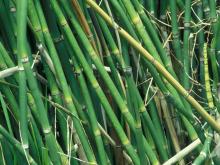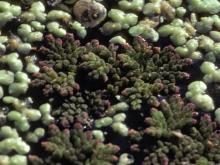Wildflowers, Grasses and Other Nonwoody Plants
Media

Species Types
Scientific Name
Equisetum (3 spp. in Missouri)
Description
Horsetails, or scouring rushes, are in the genus Equisetum. They’re easy to recognize with their jointed, hollow stems. Like ferns, they reproduce via spores instead of flowers and seeds.
Media

Species Types
Scientific Name
Onoclea sensibilis
Description
The leaves of sensitive fern usually wither quickly upon the first frost, leaving the upright, beadlike, spore-bearing spikes to be noticeable.
Media

Species Types
Scientific Name
Asplenium rhizophyllum (syn. Camptosorus rhyzophyllus)
Description
One of Missouri’s most distinctive ferns, walking fern walks. Its long, triangular leaves take root at the elongated tips, forming new plantlets.
Media

Species Types
Scientific Name
Phegopteris hexagonoptera
Description
Broad beech fern has broadly triangular leaves that tilt backward from their long, upright stalks. Wings of leafy tissue connect the main leaf lobes along the main axis, and the bottommost lobes usually point downward.
Media

Species Types
Scientific Name
Ophioglossum spp.
Description
Four species of adder’s tongue ferns occur in Missouri. They don’t look like typical ferns. They have spoon-shaped leaves and an upright spore-bearing stalk.
Media

Species Types
Scientific Name
Azolla mexicana
Description
Scooping up a handful of mosquito fern reveals it to be a mass of tiny ferns, each smaller than a dime, and consisting of many small, overlapping leaves arranged around a central stalk, with a single rootlet dangling from the plant base.
See Also
About Wildflowers, Grasses and Other Nonwoody Plants in Missouri
A very simple way of thinking about the green world is to divide the vascular plants into two groups: woody and nonwoody (or herbaceous). But this is an artificial division; many plant families include some species that are woody and some that are not. The diversity of nonwoody vascular plants is staggering! Think of all the ferns, grasses, sedges, lilies, peas, sunflowers, nightshades, milkweeds, mustards, mints, and mallows — weeds and wildflowers — and many more!





















